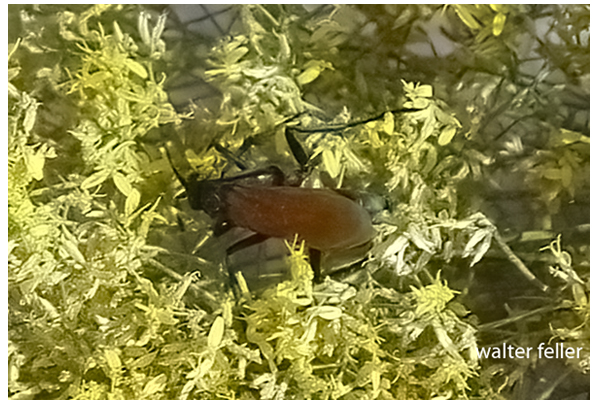Tarantula Hawk Wasp

Body lengths measures up to two inches, and the wasps are rather robust,
which provides good protection during encounters with tarantulas. The insects are metallic
blue-black with wings that are blue-black, orangish or mahogany in color. This
is another group of insects which, like velvet ants, have aposematic coloring
– that is, conspicuous warning coloring – which warns potential predators
that this is a meal that might be more painful that it is worth.
Predator and Prey
Only a few animals, such as roadrunners, eat tarantula hawks. The wasps are
"nectivorous," and they have been known to become
"flight-challenged" after consuming fermented fruit.
Habits and Habitat
Tarantula hawks are most active in the summer, during the day, although they
avoid the highest temperatures. Females give the wasps their common name. Like
all members of this genus, they require a spider to serve as host for their
larvae, and in the case of the local species, tarantulas are the preferred
nursery.
A female wasp finds a tarantula by smell. Generally, she scampers across the
ground to locate a burrow. She will enter the burrow and expel the spider, then
attack it. She may also encounter a male tarantula during his search for a mate.
In an attack, the wasp uses her antennae to probe the spider, which may raise
its front legs and bare its fangs. (A tarantula does not always counterattack.)
She then attempts to sting the spider. She might seize the spider by a leg, flip
it over on its back and sting it, or she may approach from the side to deliver a
sting. Once stung, the tarantula becomes paralyzed within seconds. The condition
will last for the remainder of its life. The wasp may drink the body fluids
oozing from the spider’s wounds or from its mouth to replenish nutrients and
water she used during the attack.
If the wasp expelled her victim, she will drag it back into its own burrow, now
a burial vault, lay a single egg on the spider’s abdomen, then seal the
chamber. If the wasp succeeds in stinging a male tarantula on a mating hunt, she
will excavate a burrow, drag the paralyzed spider inside, lay her single egg,
and seal the chamber.
Once the egg hatches, the tiny grub, initially connected to the spider by the
tip of its tail, bends over, attaches its head and begins to suck. It continues
sucking until its final moult. It then rips open the spider's abdomen, thrusts
its head and part of the thorax inside, and "feeds ravenously," as one
entomologist described it. As one might hope, even for a spider, the tarantula
at this point is finally dead.
Male tarantula wasps also lead an intriguing life. They engage in a behavior
called "hill-topping," where they perch on taller vegetation or high
points. They are strongly territorial at these sites because of the good view of
the surroundings and in particular, of newly emerged virgin females, which may
be receptive to mating. Once again we see that males of another species act
quite like males of our own species; think of males posted up at a bar keeping
an eye on the door.